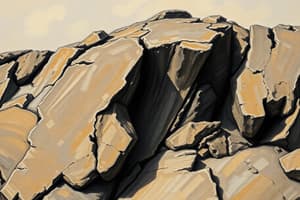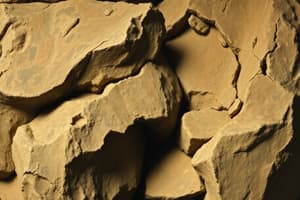Podcast
Questions and Answers
What type of stress is exerted at a transform fault?
What type of stress is exerted at a transform fault?
- Shear (correct)
- Compressional
- Confining
- Tensional
Which type of stress is primarily found at a convergent boundary?
Which type of stress is primarily found at a convergent boundary?
- Tensional
- Translational
- Compressional (correct)
- Shear
What type of stress is experienced at a divergent boundary?
What type of stress is experienced at a divergent boundary?
- Tensional (correct)
- Shear
- Confining
- Compressional
What term describes the stress on rocks caused by parallel forces moving past each other?
What term describes the stress on rocks caused by parallel forces moving past each other?
Which of the following describes the type of stress that pulls rocks in opposite directions?
Which of the following describes the type of stress that pulls rocks in opposite directions?
How do rocks deep within the crust primarily deform under high confining pressures?
How do rocks deep within the crust primarily deform under high confining pressures?
What do potentially active faults indicate about their movement?
What do potentially active faults indicate about their movement?
What results from stress applied to rocks?
What results from stress applied to rocks?
According to the principle of superposition, where would the oldest rock layer be found?
According to the principle of superposition, where would the oldest rock layer be found?
What does the principle of original horizontality indicate about sedimentary layers?
What does the principle of original horizontality indicate about sedimentary layers?
In a sequence of geological events, which of the following is true according to the principle of cross-cutting relations?
In a sequence of geological events, which of the following is true according to the principle of cross-cutting relations?
Which layer would be considered the youngest in a sequence if it has been faulted?
Which layer would be considered the youngest in a sequence if it has been faulted?
If layer C is older than layer B and layer B is older than layer A, what can be determined about the sequence?
If layer C is older than layer B and layer B is older than layer A, what can be determined about the sequence?
In relative dating, what is primarily assessed?
In relative dating, what is primarily assessed?
What indicates that an igneous intrusion is younger than the sedimentary layers it cuts through?
What indicates that an igneous intrusion is younger than the sedimentary layers it cuts through?
What occurs after the intrusion of igneous rock in geological events according to the principles discussed?
What occurs after the intrusion of igneous rock in geological events according to the principles discussed?
What distinguishes a fault from a fracture?
What distinguishes a fault from a fracture?
Which process leads to the formation of sedimentary rocks?
Which process leads to the formation of sedimentary rocks?
What is the significance of bedding in sedimentary rocks?
What is the significance of bedding in sedimentary rocks?
Who contributed to the principles of stratigraphy that geologists use today?
Who contributed to the principles of stratigraphy that geologists use today?
What do sediment layers typically represent?
What do sediment layers typically represent?
What happens to sediments deposited in calm water?
What happens to sediments deposited in calm water?
What illustration does Steno's work provide regarding fossil seashells?
What illustration does Steno's work provide regarding fossil seashells?
What happens if surface conditions remain unchanged for a long time during sediment deposition?
What happens if surface conditions remain unchanged for a long time during sediment deposition?
What defines an index fossil?
What defines an index fossil?
What does the principle of faunal succession indicate?
What does the principle of faunal succession indicate?
How does absolute dating differ from relative dating?
How does absolute dating differ from relative dating?
What role does radiometric dating play in geology?
What role does radiometric dating play in geology?
Why are certain fossil types never found with others, like human ancestors with dinosaurs?
Why are certain fossil types never found with others, like human ancestors with dinosaurs?
What is one benefit of using more than one radioactive isotope in radiometric dating?
What is one benefit of using more than one radioactive isotope in radiometric dating?
What is the significance of the breaks in relative geologic time established by geologists?
What is the significance of the breaks in relative geologic time established by geologists?
How does an organism become an index fossil?
How does an organism become an index fossil?
Flashcards are hidden until you start studying
Study Notes
Rock Deformation and Stratified Rocks
-
Plate movement results in geological features like folds and faults through tectonic interactions, including compression, tension, and shear stress.
-
Stress on rocks is the force applied per unit area, leading to deformation known as strain, which encompasses changes in size, shape, or volume.
-
Folds occur deep in the crust as colliding plates compress rocks, creating permanent curves rather than returning to their original shape.
-
Faults represent fractures where significant movement has occurred; they are characterized by the relative motion of rock bodies, such as the San Andreas Fault in California.
Stratified Rocks
-
Stratified rocks, primarily sedimentary, form from the accumulation of sediments and organic materials, exhibiting distinct layering or bedding.
-
Sediments are generated through weathering and erosion, collecting in various environments and hardening over time to create rock layers known as strata.
-
The principles of stratigraphy aid in comparing historical timelines of sedimentary layers, with important contributors including Nicholas Steno, William Smith, and James Hutton.
Principles of Stratigraphy
-
Principle of Superposition: In undisturbed layers, the oldest rock is found at the bottom, with progressively younger layers above it.
-
Principle of Original Horizontality: Sedimentary strata are typically deposited in horizontal layers unless disturbed by geological forces.
-
Principle of Cross-cutting Relationships: Features like faults or intrusions are younger than the rocks they disrupt.
Relative Dating of Stratified Rocks
-
Relative dating compares the ages of rocks without providing specific numerical dates, determining the sequence of geological events.
-
Index fossils can serve as indicators of relative age due to their widespread presence and brief existence in the geological record.
Absolute Dating of Stratified Rocks
-
Absolute dating provides specific ages for rocks using techniques such as radiometric dating, which measures the decay of radioactive isotopes over time to determine age.
-
Findings suggest that the age of certain metamorphic rocks can reach back billions of years, significantly aiding our understanding of Earth's geologic timeline.
Studying That Suits You
Use AI to generate personalized quizzes and flashcards to suit your learning preferences.




